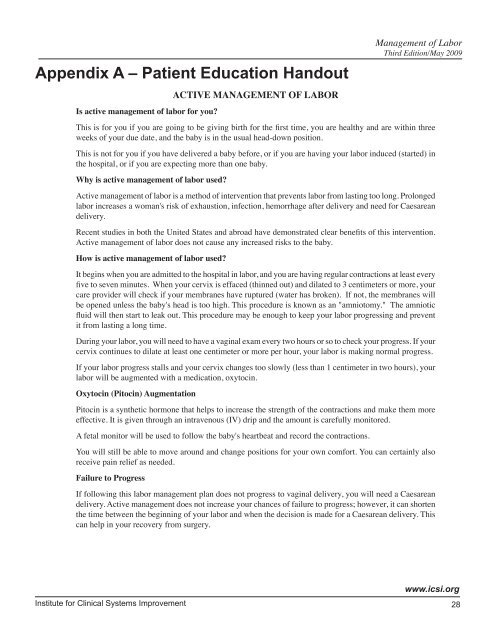Management of Labor
Management of Labor
Management of Labor
You also want an ePaper? Increase the reach of your titles
YUMPU automatically turns print PDFs into web optimized ePapers that Google loves.
Appendix A – Patient Education Handout<br />
Is active management <strong>of</strong> labor for you?<br />
Institute for Clinical Systems Improvement<br />
ACTIVE MANAGEMENT OF LABOR<br />
<strong>Management</strong> <strong>of</strong> <strong>Labor</strong><br />
Third Edition/May 2009<br />
This is for you if you are going to be giving birth for the first time, you are healthy and are within three<br />
weeks <strong>of</strong> your due date, and the baby is in the usual head-down position.<br />
This is not for you if you have delivered a baby before, or if you are having your labor induced (started) in<br />
the hospital, or if you are expecting more than one baby.<br />
Why is active management <strong>of</strong> labor used?<br />
Active management <strong>of</strong> labor is a method <strong>of</strong> intervention that prevents labor from lasting too long. Prolonged<br />
labor increases a woman's risk <strong>of</strong> exhaustion, infection, hemorrhage after delivery and need for Caesarean<br />
delivery.<br />
Recent studies in both the United States and abroad have demonstrated clear benefits <strong>of</strong> this intervention.<br />
Active management <strong>of</strong> labor does not cause any increased risks to the baby.<br />
How is active management <strong>of</strong> labor used?<br />
It begins when you are admitted to the hospital in labor, and you are having regular contractions at least every<br />
five to seven minutes. When your cervix is effaced (thinned out) and dilated to 3 centimeters or more, your<br />
care provider will check if your membranes have ruptured (water has broken). If not, the membranes will<br />
be opened unless the baby's head is too high. This procedure is known as an "amniotomy." The amniotic<br />
fluid will then start to leak out. This procedure may be enough to keep your labor progressing and prevent<br />
it from lasting a long time.<br />
During your labor, you will need to have a vaginal exam every two hours or so to check your progress. If your<br />
cervix continues to dilate at least one centimeter or more per hour, your labor is making normal progress.<br />
If your labor progress stalls and your cervix changes too slowly (less than 1 centimeter in two hours), your<br />
labor will be augmented with a medication, oxytocin.<br />
Oxytocin (Pitocin) Augmentation<br />
Pitocin is a synthetic hormone that helps to increase the strength <strong>of</strong> the contractions and make them more<br />
effective. It is given through an intravenous (IV) drip and the amount is carefully monitored.<br />
A fetal monitor will be used to follow the baby's heartbeat and record the contractions.<br />
You will still be able to move around and change positions for your own comfort. You can certainly also<br />
receive pain relief as needed.<br />
Failure to Progress<br />
If following this labor management plan does not progress to vaginal delivery, you will need a Caesarean<br />
delivery. Active management does not increase your chances <strong>of</strong> failure to progress; however, it can shorten<br />
the time between the beginning <strong>of</strong> your labor and when the decision is made for a Caesarean delivery. This<br />
can help in your recovery from surgery.<br />
www.icsi.org<br />
28
















